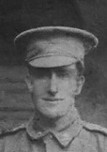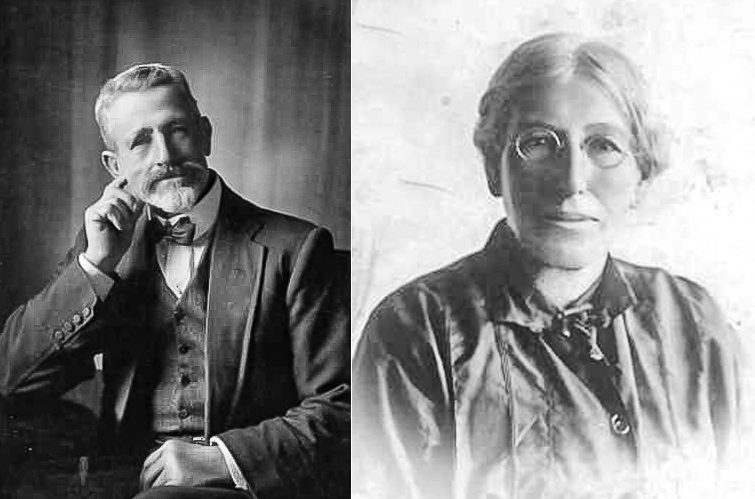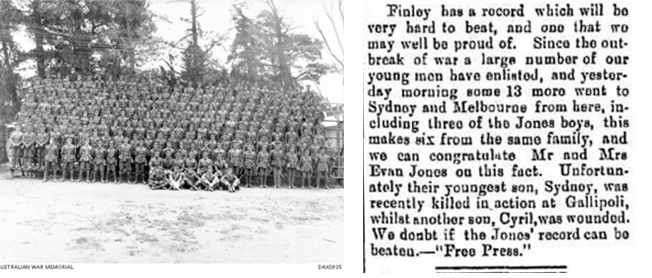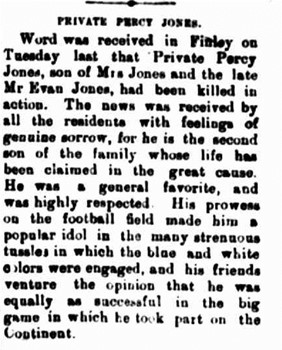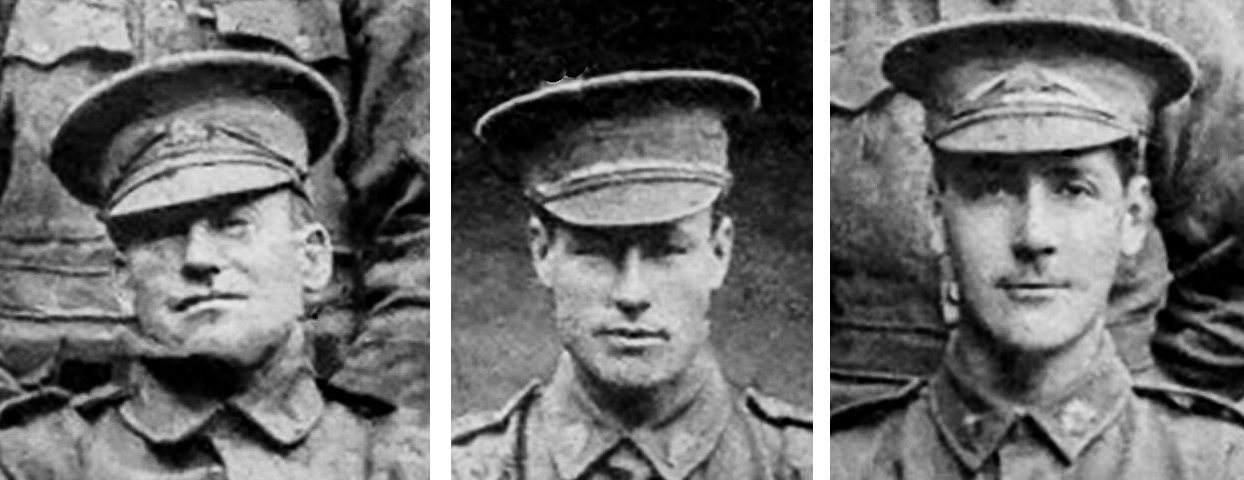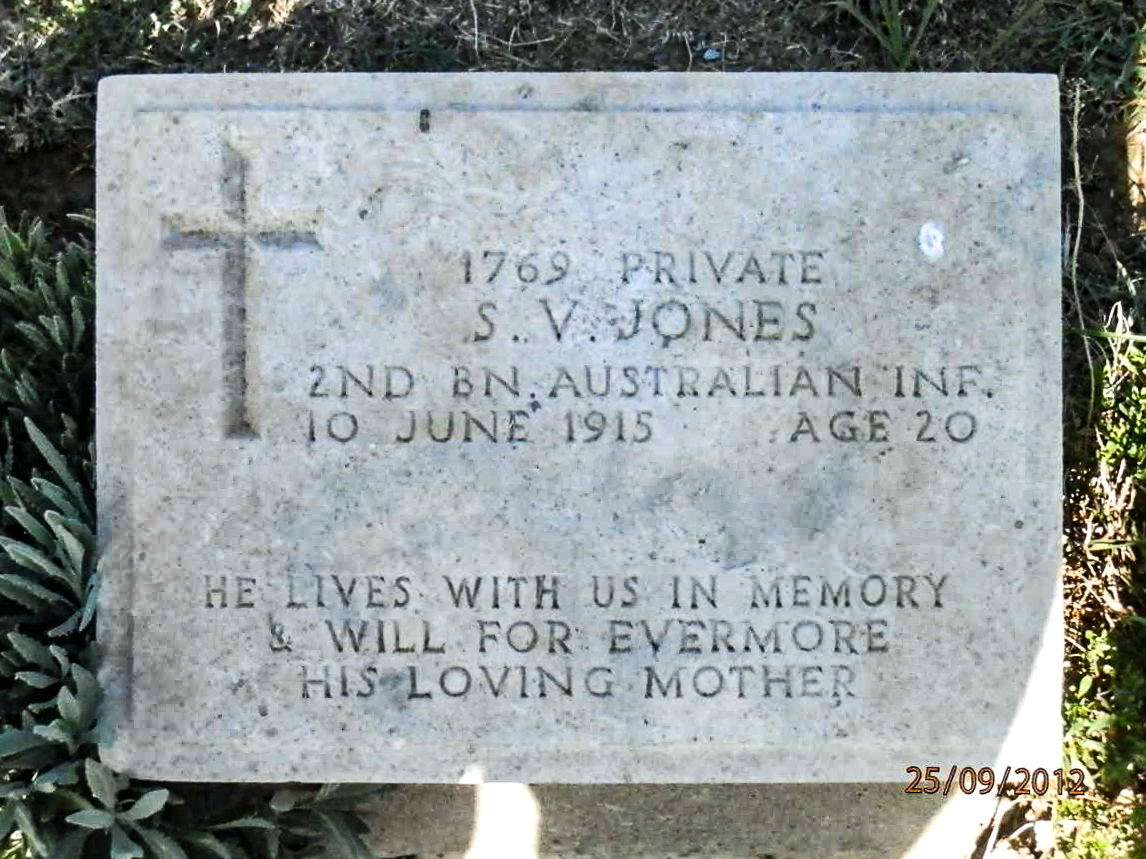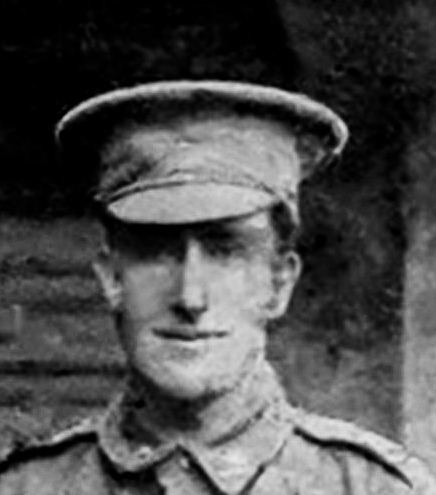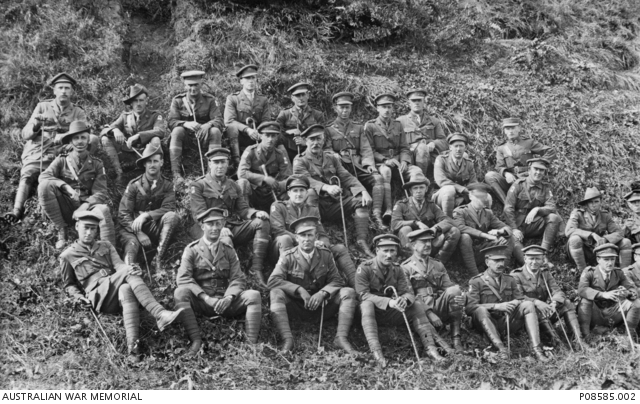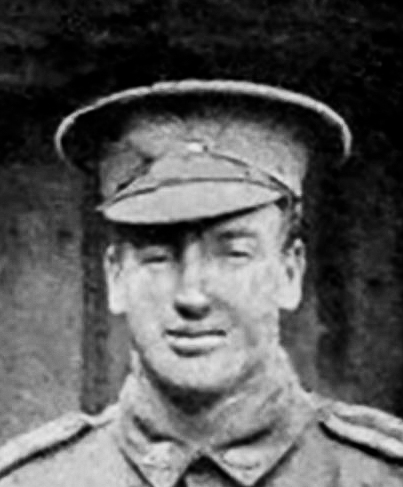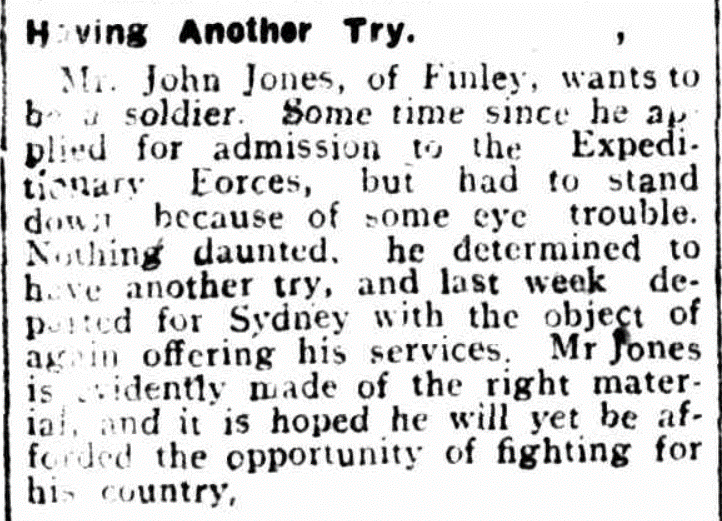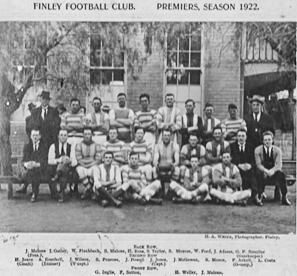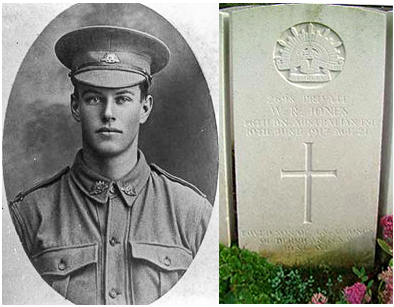Alfred Evan JONES
Eyes hair brown, Hair eyes brown, Complexion fair
A FIGHTING FAMILY - The Jones Family and their Soldier Sons
With thanks to Stephen Brooks and Great Grandson Tony Jones for their contribution to this story.
Early Life
Evan and Mary Ann (nee Walsh) Jones were originally from Wales. They immigrated to the Goulburn Valley in Yarroweyah, near Cobram, and in the 1890’s they moved across the border to Finley, New South Wales. They had thirteen surviving children born between 1874 and 1897. Norman Percy (Percy), their ninth child, was born in 1887 in Yarroweyah, which is near the Murray River in central Victoria. Their other children were:
- William Charles (1874–1951)
- Walter John (1875–1875)
- Alfred (Fred) Evan (1877–1956)
- Eva Alice (1878–1949) (Bresnan)
- Florence Edith (1879–1959)
- Rosa May (1881–1962) (Emmerson)
- Eliza Emily (1884–1960) (Bickers)
- Elsie Margaret (1884–1942) (Dick)
- Harold (Harry) Leswell (1885–1968)
- Cyril Arthur (1888–1954)
- Agnes Ethel (1891–1970) (Morgan)
- John (Jack) Myrtle (1893–1957)
- and Sydney Victor (1897–1915), killed in action at Gallipoli.
Evan and Mary Ann owned a farm called “Oakridge”, Myrtle Park, Finley. Evan ran various businesses, was extremely active in the Football, Cricket and Coursing clubs of the town as well as being an “activist” for the betterment of Finley and surrounds. Evan was at various times President of the Cobram Agricultural Show and the Southern Riverina Football Association.
Their children carried on the tradition of being highly involved Finley residents throughout their lives. Percy was first educated in Yarroweyah, but when he was about 12 years old the family moved to Myrtle Park, Finley. He grew to be a fine young man, industrious, intelligent and unassuming and he was popular with all, as well as a dashing footballer.
Percy was captain of the Finley Cats in 1914 and, with brothers Harry, George and Jack on the team, they won the 1914 Premiership in the Southern Riverina Football Association. Their younger brother Sydney was also a keen footballer.

Team: Finley—P. Jones (captain), H. Jones, G. Jones, L. Yeo, J. Jones, N. Yeo, W. Crump, R. Crawford, W, Scott, J. M'Gowan, G. Livingston, F. Brescan, J. Malone, F.Burns, L. Bresnan, S. Malone, W.Colombini and F. Pittock
Percy and his older brother Fred ran a small business together and in 1913 were sinking bores and erecting windmills in the area. The need around the Murray River districts for water for farming and stock was increasing and they were true pioneers at wells and windmills in the area. It is believed their father Evan got a man from Western Australian goldfields to visit and show them how it was done.
A Fighting Family
When the War broke out, the whole of the Jones family were committed. Of the seven sons, six enlisted. The seventh was the oldest son, William Charles and as he was in his 40’s, stayed at home to help on the farm. Four of their cousins also served, but sadly, lost their lives. Evan was very parochial about the war and saw himself as a true son of Britain.
I cannot go to the war, but I have seven sons that might. Thus Evan Jones, of Finley (N.S.W.) soon after the great outbreak in August last year. “If my boys feel as their dad does” he added, “they'll, be off, and I'll do nothing to stop them— I'll not stop them!”
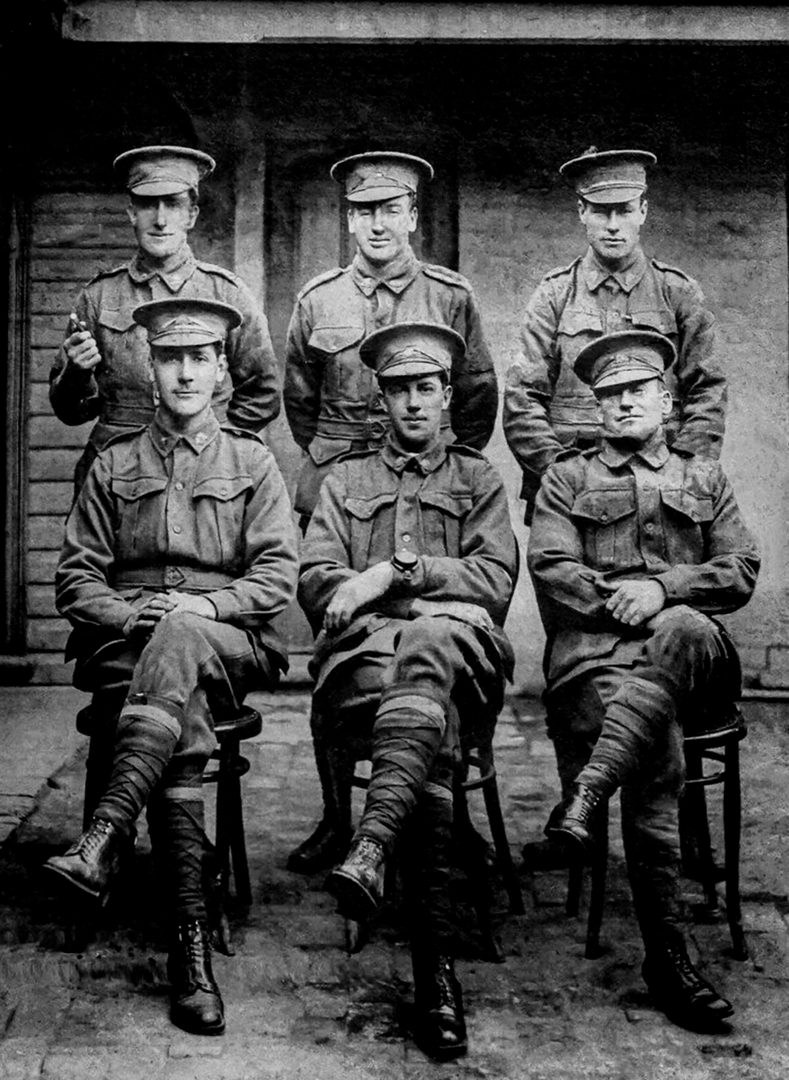
Rear (L to R) Fred, Jack, Cyril
Front (L to R) Sydney, Percy, Harry
Harry and Cyril enlisted in September 1914. In January 1915, their youngest brother Sydney, although too young, lied about his age and got a letter from his father so he could follow his two older brothers on the adventure into the Army. One rather humorous side story is that after the War had broken out, there was a legal requirement for young men to do a minimum number of hours of personal service. The police came looking for Sydney, as he had not shown up for his service…only because he had already packed his bags and shipped off when they came looking for him!:
“At the Deniliquin Police a few days ago a number of men were prosecuted for not complying with the Defence Act by rendering, personal service. Among the defendants was Sydney Jones who failed to appear. It transpired that Jones’s failure to attend his drills in Australia was due to the fact that he had volunteered for the front, and was last heard of in Egypt, where he was serving with the Australian Expeditionary Force. The charge was withdrawn.”
Percy, Fred and Jack signed up in mid-July 1915, but Jack was turned away (twice) from front line duty due to his poor eyesight. Evan’s passion comes through in remarks from when his last sons departed overseas:
“We now--now--have to fight for Australia,” said the father at a send-off to the boys. “I am glad my boys are going, as they themselves are glad to go, to fight for the grand old flag and for what it means to us. Would to God the crowds of indolent, sensual-living young men about the cities could be got to understand the perilous position of their fair, native land! I am drifting down the hill of life and I have had some hard trials, but, though I might finish my time in comparative comfort, I am feeling fit, mid would kindly go out, and do my little bit, if the military people would let me.!”
Sadly, just two weeks after Percy and Alfred left for Egypt on 10 Nov 1915, their father passed away in Finley. “Mr. Evan Jones, one of the best known, most respected, and oldest residents of Finley, met his death today from injuries received through being thrown from a gig and striking his head against a tree.”
Source: A FIGHTING FAMILY. (1915, December 24). The Farmer and Settler (Sydney, NSW : 1906 - 1955), p. 3. Retrieved October 9, 2022, from http://nla.gov.au/nla.news-article116671821
Mary Ann Jones died on 7 January 1924 from heart failure at the age of 74 while wheeling one of her grandchildren in a pram in Berrigan.
Percy – Egypt, Fromelles and Flers
Percy and Fred enlisted in mid-July 1915 and were allocated to the newly formed 29th Battalion, A Company. Their Initial training was at Seymour, before later joining other units at the Broadmeadows Camp, Melbourne. There were also several local Finley boys in the 29th Battalion A Company - Sydney Malone (294) and John Pittock (325), also part of the Finley Cats premiership team. He was also likely friends with Charles Jury (273), from Mansfield, who enlisted at the same time.
After a short period of military training, Percy and Fred embarked from Australia on 10 November 1915 from Melbourne, Victoria on board HMAT A11 Ascanius. Before departing, the soldiers had been on parade in Melbourne in front of a good crowd. In the Weekly Times (Sat 6 Nov 1915), the Minister for Defence, H.F. Pearce said:
“I do not think I have ever seen a finer body of men.”
They arrived in Egypt on 7 December. With all the recruits coming in from Australia, reorganizations were going on and, in early March, the brothers were separated with Fred moving to the 5th Pioneers. Percy’s training with the 29th continued until mid-June with postings at Ismailia, Tel el Kebir, Ferry Post and Moascar. The troops were reviewed by the Prince of Wales while in Tel el Kebir.
The call to the Western Front for the 29th came and on 16 June and Percy boarded the troop ship Tunisian in Alexandria, headed to Marseilles, arriving on the 23rd. He was then on a train north to Hazebrouck and to Steenbeque and by the 26th was encamped in Morbecque, about 30 km from Fleurbaix.
On 9 July the 29th were moved to Erquingham, just outside of Fleurbaix and on the 10th they got their first experience in the trenches, with the “men all in good spirits”. Source AWM4 23/46/12 29th Infantry Battalion July 1916 page 3. They were back at their billets in Fleurbaix four days later.
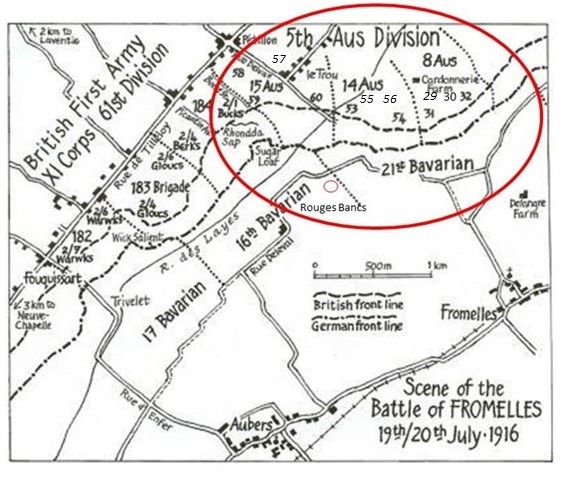
The 29th’s role was to be a ‘fourth’ battalion on the left flank of the attack. With the 30th, they were to provide support for the attacking 31st and 32nd Battalions by digging trenches, carrying supplies/ammunition and to be called in as reserves if needed for the fighting. The original attack was planned for the 17th, but bad weather caused it to be postponed.
On 19 July the 29th were in the rear trenches, ready for the attack. The 32nd’s charge over the parapet began at 5.53 PM and the 31st’s at 5.58 PM. There were machine guns emplacements to their left and directly ahead at Delrangre Farm and there was heavy artillery fire in No-Man’s-Land. The initial assaults were successful and by 6.30 PM the Aussies were in control of the German’s 1st line system.
By 8.00 PM, Percy’s A Company and D Company began to carry bombs and supplies to the front trenches. While advancing, the Australians’ left flank had also come under heavy bombardment with high explosives and shrapnel. Return bombardment support was provided and the 32nd was told:
“the trenches were to be held at all costs”.
At 10.00 PM, additional support was being requested and C and D Companies joined in. The Germans counterattacked and at 2.00 AM and Percy’s A Company was drawn directly into the fighting. B and C Companies continued to carry supplies and provided cover for soldiers who were retiring from the battle. At 4.00 AM the Germans began an attack from the Australian’s left flank, bombing and advancing into the communications trench along their left flank.
Given the Australian advances that had been made earlier, portions of their rearward trench had been left almost empty, which then enabled the Germans to be in a position to surround the advanced soldiers. As the Australian attack had been halted, they became exposed in a salient jutting into the German lines and were quickly enfiladed by German machine guns:
“In the end, they basically had to fight their way back to their own lines, 'run for it', or be killed wounded or captured.”
In the morning the battle was over and Percy had survived. For a battalion supposed to be in a support role, the initial figures of the impact of the battle on the 29th were - 17 soldiers killed, 161 were wounded and 68 were missing. Ultimately, 63 soldiers of the 29th Battalion were killed in action or died of wounds from the battle. The 29th were left to hold the front line and, even though a cease fire was not in effect, were busily bringing back a large number of wounded during the day and night. The nature of this battle was summed up by Private Jim Cleworth (784) from the 29th:
"The novelty of being a soldier wore off in about five seconds, it was like a bloody butcher's shop".
Percy remained at Fleurbaix until 21 September, holding the lines. They were then moved to Armentieres. On 17 Oct they took a train south to Bussus and marched to Mametz Wood and Flers, which are about 80 km south of Fleurbaix. They arrived on 22 October and, in terrible weather conditions, Percy’s A Company went straight into the battle in the front trenches, which were knee deep in mud:
“At dawn (23 October), signs of the recent fighting were plainly to be seen as enemy dead as well as English, were thickly scattered over the whole area.”
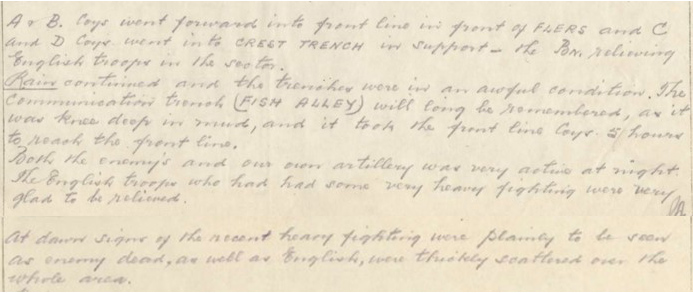
The heavy artillery bombardment continued on the 23rd and it and the continued rain sealed Percy’s fate. Percy’s body was not found. Later that day, the 29th pulled back from the front lines. He was officially listed as killed in action on 23 October 1916, aged 29. His family were notified in mid-November. He was clearly missed at home and in the community.
Percy has no known grave, but he is commemorated :
- Villers Bretonneux Memorial
- The Australian War Memorial
- Finley War Memorial.
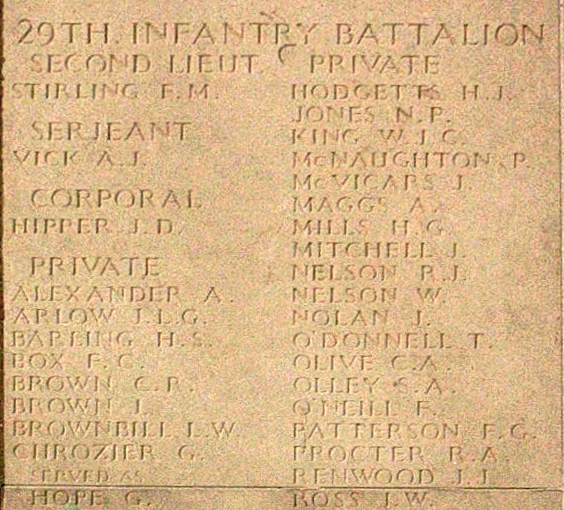
Harry, Cyril and Sydney – Gallipoli
Harry and Cyril had been the first to enlist, on 10 September and 14 September 1914, and were assigned to the 13th Battalion, B Company. Sydney had joined in January 1915 and was in the 2nd Battalion 4th reinforcements. Harry and Cyril landed at Gallipoli on 25 April 1915 and both survived the landings, but were wounded later.
Sydney arrived at Gallipoli in May 1915, but was killed on 10 June 1915 (having just turned 18 years of age). The war diary for that day simply states:
“Casualties, many wounded”.
The family was devastated by his loss. He was reportedly the first soldier killed in action from Finley during WW1. Sydney was originally buried in Browns Dip North Cemetery. He was re-interred at Lone Pine Cemetery in 1923 when the old cemetery eroded.
Cyril was wounded on 15 May and then was badly wounded on the 26 May when a bullet removed some fingers and smashed his wrist. He was sent home to Australia in December 1915, no longer fit for service. Harry was wounded on 23 August 1915 and had to have a finger amputated. He eventually went on to fight with the 45th Battalion in France. He was later invalided and sent home in 1918 due to complications from his Gallipoli wounds/amputation.
Fred – France
After a short time with Percy in Egypt, Fred was transferred to the 5th Pioneer Battalion on 3 March 1916. The 5th Pioneer Battalion was established at Tel-el-Kebir on 10 Mar 1916. While trained as infantrymen, they were also tasked with digging trenches, constructing strong points and light railways and undertaking battlefield clearance. Their first major action was at Fromelles on 19 July 1916, where the Australians made their debut on the Western Front. Two companies of pioneers were assigned to support the attack, and it proved to be a difficult entry into the European war.
The battalion took part in the pursuit of German forces as they withdrew towards the Hindenburg Line. In March 1917 they extended the 5th Division's supply railway to Bealencourt and in April they extended the line towards Vaulx–Vraucourt, providing the means for the Allies to bring up guns and ammunition to lay down a heavy bombardment on the Hindenburg Line.
Fred was promoted to Lance Corporal in December 1916, Corporal in March 1917 and became a Sergeant in July 1917. From December 1917 to February 1918 he was in and out of hospital in England and was extremely unwell with chronic rheumatism and severe myalgia. He returned to Australia in March 1918 and was officially discharged in June 1918.
Jack – Tried to do his part
Jack tried to enlist, but was turned down due to poor eyesight that was determined to be unsuitable for the front lines. He tried again with his brothers Percy and Fred in July 1915. He remained in Australia and spent some time in home duties, but was discharged in Feb 1916.
After the War
When the brothers returned home, the family tradition of being highly involved Finley residents continued. Harry and Jack were involved in organising the purchase of lands from the Crown for Soldier Settlements in Finley and they had land in Finley that they managed. The family football traditions also carried on. In 1922 Harry was the coach and Jack was the captain of the Premier wining Finley Cats, but the team were missing both former Captain Percy and Sydney.
Fred went on to marry Emma in 1919. They moved to Griffith, NSW and had two daughters Nancy and Beryl. He passed away, aged 79, on 31 October 1956 in Griffith NSW. Harry wed Catherine in 1926. Harry eventually moved away from the district and settled in Melbourne. He passed away on the 4 August 1968 in Melbourne, aged 82. Cyril married Helen in 1919 and they had 3 children, Sydney, Albert and Dorothy. He died in Melbourne on 10 January 1954, aged 66. Jack married Emily in 1916 and had 7 children. He passed away in 1957 in Melbourne.
Four Jones Cousins gave their lives as well
Wilfred “Fred” Raymond Jones, 2698, (1st Cousin) from Berrigan, is the son of John and Agnes Jones of Yarrawonga, Victoria. Fred served in the 46th Battalion and died 3 days after he received wounds in The Battle of Messines on 10 June 1917 at 21 years old. He is buried in the Bailleul Military Cemetery.
Edward “Ted” James Walsh, 2896, (1st Cousin) son of William James and Martha Walsh from Waaia near Nathalia, Victoria was killed in action on 13 October 1917 at Passchendaele whilst serving with the 67 Battalion, aged 22. He has no known grave and is commemorated at the Ypres (Menin Gate) Memorial (Panel 29), Belgium.
Edward Barker Kirk, 1999, (2nd Cousin) born at “Mt Pleasant” Toolleen, Victoria was killed in action at Pozieres on 5 August 1916 while serving with the 2nd Division Light Trench Mortar Battery, aged 43. He has no known grave and is commemorated at Villers-Bretonneux, France.
Peter Edward Barker, 5974, (2nd Cousin) born in Swan Hill, Victoria was killed in action on 15 July 1917 with the 37th Battalion, aged 25. He is buried at Kandahar Farm Cemetery, Neuve-Eglise (Plot II, Row A, Grave No. 19), Belgium.
The Jones Family Legacy – ‘Endorsed’ by Pompey Elliott
Although what the soldiers endured must have been hell, one can only imagine the stress and torment of those left behind in Finley must have felt as they prayed for their loved ones to return. Aside from Mary Ann Jones, two sons (William and Jack) plus six sisters remained behind (Eva, Florence, Rosa, Eliza, Elsie and Agnes).
The Jones brothers of Finley have not been forgotten. In 1919 none less than Brigadier General “Pompey” Elliott came to open the Finley Avenue of Honour. The second and third trees planted were to remember Norman Percy Jones and Sydney Victor Jones:
“Brig.-General Elliott was accorded a warm reception at Finley on Saturday afternoon, when he participated in the ceremony of planting the first trees in the Avenue of Honor.
There was a large attendance of town and district residents and returned soldiers, and Brigadier General Elliott was accorded a most enthusiastic reception at the School of Arts, here Cr. A. Erskine, in a fitting speech of welcome, voiced the feeling of pleasure and honor which prevailed amongst all present, that they should be favored with the presence of such a distinguished visitor. In reply Brigadier-General Elliott emphasised the pleasure which he felt at the warm welcome extended him, and thanked them heartily.
The ceremony of planting the first tree in the Avenue of Honor was then proceeded with, and, in fulfilling this duty at the invitation of the residents of Finley, Brig.- General Elliott paid a warm tribute to the "Diggers" with whom he had been associated “over there," and said it gave him great pleasure in being present to assist in establishing the Avenue, which was a recognition of the spirit of the men of Finley who had gone to fight overseas.
The General then planted the first tree, in honor of the late Private Finley Dobinson, the first man to enlist from Finley, and who had paid the supreme sacrifice for his country. The second tree was planted by General Elliott's mother, in memory of the late Sergeant Percy Jones; and Mrs. Elliott planted the third to the memory of another member of the patriotic Jones family, Private Sydney Jones, who also paid the great price. Mrs Erskine performed duty of planting the fourth tree in honor of the late Private Leslie Boyd, this concluding the day's ceremony.
Brigadier-General Elliott was afterwards entertained at a banquet in the School of Arts, which was crowded. Cr. Erskine presided, and the proceedings were of a most enthusiastic nature.”
The Jones sons who were able to serve are remembered on the Finley War Memorial.
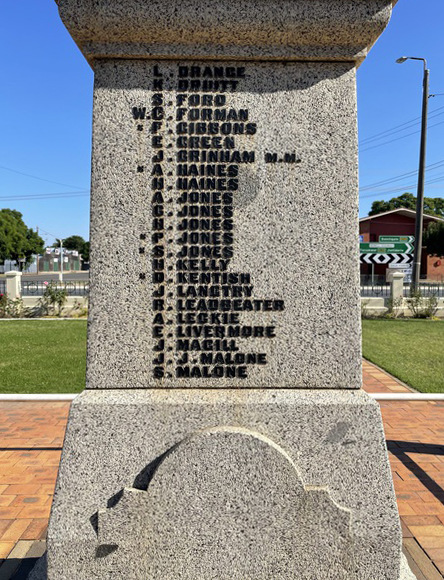
Five brothers who served
It is certain that Evan Jones would have been proud of ALL of his family.
The Fromelles Association would love to hear from you

Contacts
(Contact: carla@fromelles.info or geoffrey@fromelles.info).
(Contact: army.uwc@defence.gov.au or phone 1800 019 090).
Donations
If you are able, please contribute to the upkeep of this resource.
(Contact: bill@fromelles.info ).
